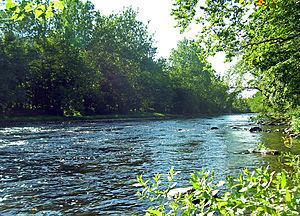- elevation 2,960 ft (902 m) - elevation 1,600 ft (488 m) Length 105 km Bridges Halls Mills Bridge | - elevation 3,480 ft (1,061 m) Basin area 1,127 km² Discharge 6.003 m³/s | |
 | ||
- location S of Claryville, Sullivan County | ||
Neversink river unique area
The Neversink River (also called Neversink Creek in its upper course) is a 55-mile-long (89 km) tributary of the Delaware River in southeastern New York in the United States. The name of the river comes from an Algonquian language phrase meaning "mad river."
Contents
- Neversink river unique area
- Map of Neversink River United States
- 36680 private american fly fishing estate on the neversink river
- CourseEdit
- RecreationEdit
- HistoryEdit
- References
Map of Neversink River, United States
Because of Theodore Gordon expertly matching dry fishing flies to actual insects in the 1890s, and due to the research of Edward Ringwood Hewitt from his property above the town of Neversink, the Neversink River is considered by many to be the birthplace of American dry fly fishing.
36680 private american fly fishing estate on the neversink river
CourseEdit
The Neversink's main flow begins just south of the border between Ulster and Sullivan counties, where the east and west branches of the river join near the hamlet of Claryville. Both branches begin on the slopes of Slide Mountain, the highest peak in the Catskills. The west branch is joined by several major tributaries, such as Biscuit Brook and Pigeon Creek at Frost Valley YMCA in the town of Shandaken, Ulster County. In its upper course it is a rocky and wild stream, ideal for trout fishing although most of the land around it is privately owned.
Not far downriver from the confluence in Neversink, it is impounded to form the Neversink Reservoir. It is connected by a 5-mile (8 km) water tunnel to Rondout Reservoir, and subsequently to the Delaware Aqueduct. The Neversink Reservoir resulted in the displacement of many locals as several towns along the river were flooded to make the reservoir.
It flows generally southeast through the mountains and is impounded in the town of Neversink to form the Neversink Reservoir of the New York City Water Supply System. It flows through the town of Fallsburg, the hamlets of Woodbourne, South Fallsburg, and Old Falls. It then enters the town of Thompson near Bridgeville, where it intersects New York State Route 17/Interstate 86 at Exit 107. It runs past Holiday Mountain Ski Area. In southern Sullivan County, it returns to less developed country, going over its largest waterfalls, Denton Falls and High Falls in the Neversink Gorge. It then turns southeastward into western Orange County. Near Cuddebackville, it is joined from the northeast by Basher Kill, then flows southwest, paralleling US 209, joining the Delaware at Port Jervis, at Tristate Rock, where New York, New Jersey, and Pennsylvania converge underneath the Interstate 84 bridge.
RecreationEdit
Along much of its length it is a popular trout stream, mostly north of Woodbourne. In addition to rainbow trout it sustains brown trout, brook trout and the rare tiger trout. The river is home to other fish species such as smallmouth bass, carp, sucker, bluegill, American eel,lampreys and a diverse range of flora and fauna. Other forms of recreation are rarely pursued on the river. Several swimming holes are available, however many are on private property or restricted public property. The relative narrow nature of the river allows for limited boating. The river is mostly navigable with small watercraft from near its dam in Hasbrouck to its mouth, however, it is seldom traveled. In the late 19th century the river was said to have been navagable to Claryville, where a tannery existed. The river may have been a popular route for the tannery's trade as well as smaller steam propelled vessels.
It was formerly crossed by the Delaware & Hudson Canal at Cuddebackville by an early aqueduct bridge designed by John Roebling and built in 1851.
HistoryEdit
In heavy rains it sometimes floods near its mouth. This occurred most recently in April 2005, causing some destruction and dislocation in the Port Jervis area, particularly the Myers Grove community near Huguenot, that continues to have an effect. In addition, heavy rains in combination with an extended period of unusually warm weather after a moderate to heavy winter with a considerable snowpack can produce devastating floods at the headwaters of the river from January to April.
A detailed history of the river can be found in James Eldrige Quinlan's History of Sullivan County, published in 1873.
